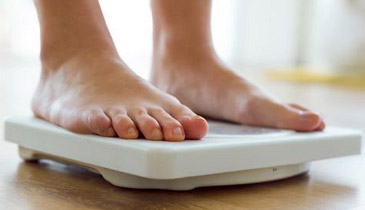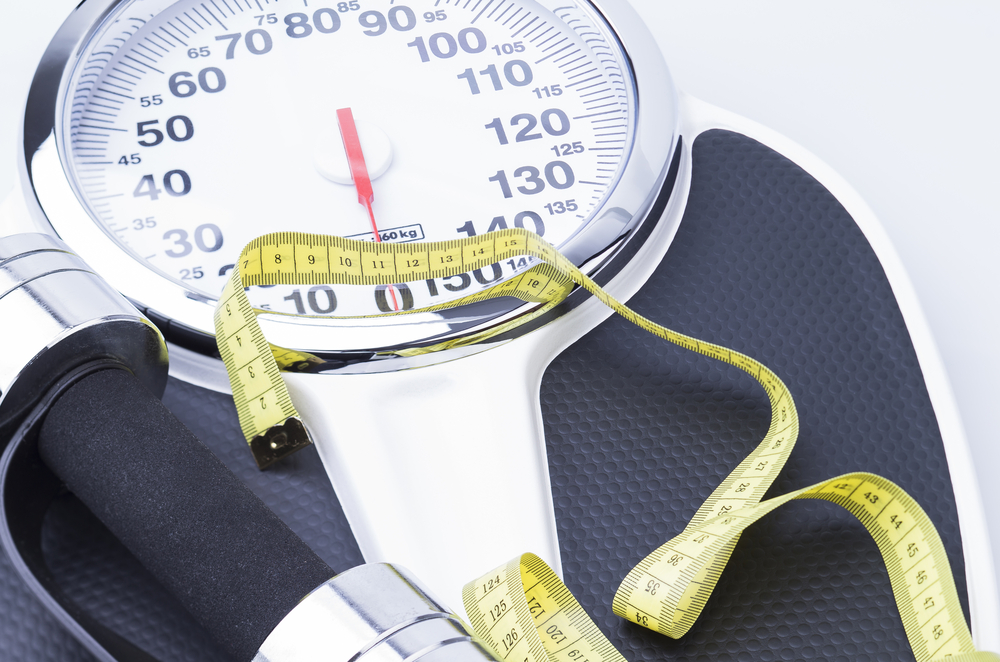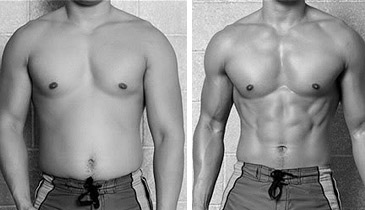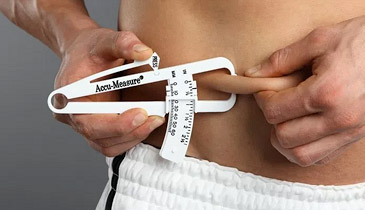HOW TO TRACK PROGRESS DURING A CUTTING PHASE
What’s the proper way to track progress while cutting? In this article we’ll go over everything you need to know on the subject to maximize your fat burning results.
In a previous post we discussed how to track progress while bulking.
In this article, I’ll be going over the other side of the equation by explaining how to track progress during a cutting phase so that you can:
- Maximize your rate of fat loss while maintaining lean muscle (and possibly even gaining some).
- Keep your hunger and energy levels under control to ensure that you’re able to stick with your cut from start to finish.
There are actually many similarities between tracking progress for cutting and bulking. The same basic metrics will be used for both but will simply be applied in a slightly different way.
The two most important ones to pay attention to during a cutting phase are your changes in body weight and strength.
You can then use progress photos, measurements and (optionally) body fat percentage readings to get some extra information and ensure you get the best results possible.
Let’s break it down step by step…
How To Track Fat Loss Progress
Cutting Progress Tracking Method #1: Body Weight

For most people, a standard rate of overall weight loss to aim for during a cutting cycle is between 1-2 pounds per week.
The vast majority, if not all of that, will be in the form of body fat if you’re doing everything in your program correctly.
You might see a faster initial drop of about 3-4 pounds in the first week or so while your body flushes out excess water retention, glycogen levels decrease, and the overall food volume in your system reduces, but this should stabilize somewhere in that 1-2 pound range after that.
If you’re carrying a more moderate amount of body fat — say, below about 20% for men and about 28% for women — then you’ll probably be closer to the 1-1.5 pound per week range. This is because as you get leaner, it becomes more difficult to lose body fat.
If you’re more on the overweight side, then a full 2 pounds would be possible. Sometimes up to 3 pounds is even possible if you’re significantly overweight, at least in the beginning stages of your program.
That would be fairly rare though and for most people, it should ideally land somewhere between 1-2 pounds per week. This amount is large enough to produce a significant ongoing rate of fat loss, but small enough that you’ll maintain your existing lean mass while keeping your energy and hunger levels in check.
Tracking Weight Loss Accurately

To track your weight accurately, you’ll want to weigh yourself on a digital scale first thing in the morning before eating and after using the washroom.
It’s important to keep the reading as consistent as possible each time and then compare your average weight for the week to your average weight for the previous week.
Keep in mind that your weight can fluctuate up and down quite a bit between any two individual days for a wide variety of reasons, so make sure to think bigger picture rather than obsessing over your exact weight from day to day.
You don’t necessarily have to weigh yourself every single day, but at least every 2-3 days would be ideal.
As long as you’re landing somewhere within the 1-2 pound range on a consistent basis, you’ll know that you have a proper calorie deficit in place for fat loss.
If you’re achieving this rate of fat loss, you can just continue on with your current approach until or unless your body weight plateaus.
Not losing weight on the scale?

If your bodyweight is decreasing at less than one pound per week — or if it’s completely stagnant altogether — this indicates that either your calorie deficit is too small or that you don’t even have a deficit in place at all.
This would happen either because you’ve set your daily calorie target too high, or your intake is set at the proper level, but you’re accidentally overshooting it without realizing it.
The first thing I would recommend doing in this situation would be to conduct a “dietary audit”.
This is where you go through your entire diet piece by piece, making sure to properly track every single food and drink item you’re consuming with no exceptions. Doing so will allow you to see what your true calorie intake really is.
In most cases when people say “I’m eating a low calorie diet so why can’t I lose weight?” they’re actually consuming far more calories than they realize.
This is extremely common and research has clearly shown that most people significantly underestimate how many calories they’re taking in, often up to margins of error as high as 40%.
When you’re in a cutting phase, hunger levels will automatically increase due to changes in hormones such as ghrelin and leptin. While there are certain things you can do to reduce hunger while cutting, it’s ultimately a normal part of the fat loss process and is something you should expect to some degree.
However, just keep in mind that it will make it a lot more likely that you’ll unconsciously overeat.
When you consider that a standard calorie deficit for fat loss is usually only about 350-500 calories below maintenance per day, all it really takes is a few errors to significantly reduce your calorie deficit or even eliminate it altogether.
Remember that it’s your average calorie intake for the week as a whole that truly matters, rather than your intake between individual days.
For example, if you ate 500 calories below maintenance from Monday to Friday, that would be a 2500 calorie deficit in total. But when you then go and eat an extra 1000 calories above maintenance on Saturday and Sunday as a way to reward yourself, most of your deficit will have gone to waste for the week.
If after auditing your diet it turns out that you weren’t actually hitting your calorie target as closely as you thought, you’ll just need to be more diligent with your dietary tracking moving forward.
Start weighing out your food on a scale to make sure that all of the measurements are being done correctly and ensure that every single food and drink item is being accounted for during the day and during the week, as well as any extra cheat meals or cheat days.
On the other hand, if it turns out that you really have been consuming your targeted calorie total, this just means that the calorie target itself is too high and that it doesn’t represent a true calorie deficit for you.
In that case you’ll want to decrease your daily intake in increments of about 100-150 calories every 5 to 7 days or so until you’re consistently losing 1-2 pounds of weight per week.
If your weight plateaus again in the future, simply apply this same process again.
Keep in mind that in addition to adjusting your calorie intake in order to create a calorie deficit, the other option is to increase your calorie expenditure. Remember, calories in versus calories out is the ultimate bottom line here.
Performing some additional activity during the week, whether it’s an extra cardio workout or just any form of physical activity, is another route that you can follow, especially if you aren’t that active outside of weight training.
Doing a combination of both at the same time (decreasing calorie intake and increasing calorie expenditure) is an option too.
It obviously takes a larger time and energy investment to actively burn more calories as opposed to just consuming less, and this is why adjusting your calories is usually the easier and more efficient option.
However, if you’ve hit a point where you don’t want to drop your food intake any lower, then you can go ahead and create the additional deficit through exercise instead. This would especially apply if you’re in the later stages of a cut and you’re already eating at a fairly low calorie level.
Losing weight too quickly?
If your body weight is dropping too quickly, then the solution is the opposite approach.
This situation implies that your overall calorie deficit is too large, and you would need to increase your calorie intake and/or decrease your calorie expenditure to get yourself back down to the proper level.
Keep in mind that if you are losing more than two pounds per week but you feel fine in terms of hunger, energy and strength levels, then this should ultimately be fine.
There’s nothing inherently wrong with using a slightly more aggressive calorie deficit, at least in the short term.
But if hunger does become an issue, or you’re feeling very fatigued throughout the day and are losing strength in the gym, then you’ll want to decrease the size of your calorie deficit to help offset these adverse effects.
One other situation that you could find yourself in is where your body weight is decreasing at a slower pace, but you’re still seeing clear body composition improvements.
For example, perhaps you’re only losing half a pound per week but your waist measurement is consistently going down, your clothes are fitting better and your levels of visible muscle definition are clearly improving.
If that’s the case, then there’s a good chance that you’re actually re-compositioning.
This means that you are losing fat, but you’re also gaining some additional muscle mass at the same time. Essentially, your body is breaking down its fat stores and using those calories to build muscle.
If this occurs, your overall bodyweight won’t change as significantly as somebody who’s mainly just losing body fat alone.
If you do find yourself in this situation (which is the most favorable situation you could hope for during a cutting phase), then you can simply leave your nutrition and training as is for the time being.
Just keep doing what you’re doing and use the other progress tracking methods below to gauge your results. Only adjust your calories or your cardio if the other metrics start to plateau.
Cutting Progress Tracking Method #2: Changes In Strength

Aside from your body weight, the other primary progress tracking factor to pay attention to during a cut is your strength in the gym.
The main goal of a cutting phase is of course to lose body fat. However, maintaining muscle (or possibly even gaining some) should be a central goal as well.
The single best way to determine if you’re doing this successfully is to monitor your changes in strength.
The bottom line is that if you’re consistently dropping around 1-2 pounds per week and your strength numbers in the gym are continuing to increase (or at the very least are staying the same), then you can be fairly certain that the vast majority of your weight loss is coming in the form of body fat.
Do keep in mind that that you’re usually not going to gain strength to the same degree while cutting as you would during a bulk. That said, you should still be aiming for progressive overload as best you can.
Clear strength losses should only be happening during more prolonged cutting phases where you’re dropping a large amount of bodyweight or where you’re cutting to a very lean body fat percentage.
Even in this case, your performance shouldn’t fall much beyond a couple of lost reps for smaller isolation lifts and a very slight reduction on larger compound movements.
As we talked about in the bulking article, your training logbook is a vital progress tracking tool.
You should be recording all of your exercises, weights, sets and reps for each session and then striving to improve on those numbers whenever possible, or at least maintain them as a minimum.
If your strength is noticeably dropping throughout your cut — even though you’re continuing to train with sufficient intensity — this could mean one or more of the following:
- Your calorie intake is too low.
- You’re performing too much extra cardio.
- You’re not taking in enough daily protein.
Another possibility is you that might need to reduce your overall training volume or frequency. If you’re in a calorie deficit, it’s more difficult for your body to recover due to the calorie restriction.
So, if you’re on the higher end in terms of workout volume and frequency, cutting back on the total number of weight training workouts that you’re doing per week could help (for example, 5 weekly workouts down to 4, or 4 down to 3), or reducing the actual volume per session in terms of total sets. Usually, a 20-25% reduction is a good place to start.
Overall, if your body weight is decreasing at an appropriate pace and you’re maintaining your existing strength levels (or increasing them), then you can pretty much guarantee that you’re on the right track.
This indicates that you’re losing body fat consistently while preserving your lean mass.
Cutting Progress Tracking Method #3: Progress Photos

Two other ways that you can fine-tune your cutting progress tracking further is to take progress photos and body part measurements.
This will help to give you an even clearer picture as to how your physique changes are coming along.
Simply eyeballing the mirror is an option as well, but since we see ourselves in the mirror every single day it can often be hard to notice the subtle changes taking place.
Progress photos can be taken during a cutting phase every 1-3 weeks.
Don’t expect to see mind-blowing changes from one set of pictures to the next, but over a few sets of pictures you’ll definitely see the results adding up if you’re doing things properly.
It can also be very motivating to be able to look back at your previous pictures from down the road to see just how far you’ve come.
In order to be as accurate as possible with this, make sure to:
- Take your photos first thing in the morning before training or eating.
- Use the same angles and the same lighting each time.
- Take a photo from the front, side, and back.
- Take photos of yourself flexed and unflexed.
Cutting Progress Tracking Method #4: Body Part Measurements

To gain even further insight, you can measure the following body parts first thing in the morning before any activity:
- Chest
- Upper arm
- Waist
- Thigh
If you want to get even more detailed with this then you can also add in measurements for your neck, forearms and calves.
Measure around the largest part of each area to be as consistent as possible. If you measure differently each time then the readings aren’t going to be of much use or could potentially even throw you off.
Most measurements are taken unflexed, though the upper arm is the one area that most people tend to measure flexed. Whether you use a flexed or unflexed measurement, the most important thing is just that you’re measuring the same each time.
Photos and measurements are especially important in the case of a recomposition in order to show how your levels of leanness and muscularity are changing even if your body weight is going down at a slower pace.
Cutting Progress Tracking Method #5: Body Fat Percentage

The main reason you’d want to know your body percentage is to determine how much of your weight loss is coming from fat versus lean muscle.
However, you can pretty easily determine this without actually needing to precisely measure your body fat.
As long as your body weight is decreasing within the recommended 1-2 pound per week range, you’re consuming sufficient daily protein (0.8g per pound of body weight or more), and your strength levels in the gym are either maintaining or increasing, that right there is a pretty clear indication that the majority of your weight loss is coming in the form of body fat.
In addition, getting accurate body fat readings is very difficult to do in the first place.
Even DEXA scans (the gold standard for body fat testing) can be off by 1-2% or more, and if your readings are inconsistent then they could do you more harm than good. It could lead you to believe that your body fat percentage has stagnated when it’s actually decreasing, or that it’s decreasing when it actually isn’t.
For these reasons, tracking your precise body fat percentage won’t be necessary.
If you do have a method in place that can give you consistent readings (perhaps a scale, calipers or even DEXA scans), then you can optionally use one of these methods to track the relative change over time.
Just make sure to only take the readings with a grain of salt rather than relying on them completely.
Depending on the size of your calorie deficit, roughly a 1% loss in body fat every 1-2 weeks would be a good level to aim for.
Summary
In order to ensure that your fat loss program is on the right track, employing a basic progress tracking system is key.
This will allow you to accurately see that you’re losing fat on a consistent basis while maintaining (or possibly gaining) lean muscle at the same time. It will also help you recognize when your progress has stalled and when certain program adjustments are needed.
The two most important metrics to pay attention to are changes in your body weight and strength, with progress pictures, measurements and (optionally) body fat percentage readings being used to gain additional insight.
You don’t need to completely obsess over every ounce of fat you gain or lose, but measuring your results objectively can have a significant impact on your overall rate of fat loss and can even make the difference between long term success and failure.
If you found this article helpful, make sure to sign up for your FREE custom fitness plan below...





